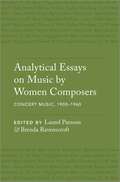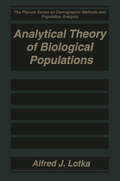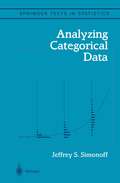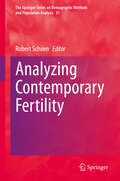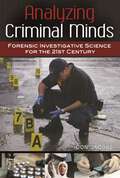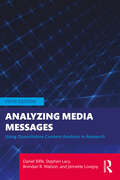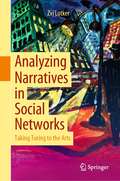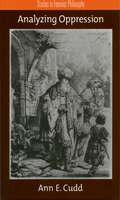- Table View
- List View
Analytical Essays on Music by Women Composers: Concert Music, 19001960
Through musical analysis of compositions written in the first half of the twentieth century, Analytic Essays on Music by Women Composers: Concert Music, 1900-1960 celebrates the achievements of eight composers: Alma Mahler-Werfel (1879-1964), Rebecca Clarke (1886-1979), Dame Ethel Smyth (1858-1944), Ruth Crawford (1901-53), Florence B. Price (1887-1953), Galina Ustvolskaya (1919-2006), J. M. Beyer (1888-1944), and Peggy Glanville-Hicks (1912-90). Written by outstanding music theorists and musicologists, the essays provide thought-provoking in-depth explorations of representative compositions, often linking analytical observations with questions of meaning and sociohistorical context. Each essay is introduced by a brief biographical sketch of the composer by editors Laurel Parsons and Brenda Ravenscroft. This collection - Volume 2 in an unprecedented four-volume series of analytical studies on music by women composers - is designed to challenge and stimulate a wide range of readers. For academics, these thoughtful analytical essays can open new paths into unexplored research areas in the fields of music theory and musicology. Post-secondary instructors may be inspired by the insights offered in these essays to include new works in music theory and history courses at both graduate and upper-level undergraduate levels, or in courses on women and music. Finally, for soloists, ensembles, conductors, and music broadcasters, these detailed analyses can offer enriched understandings of this repertoire and suggest fresh, new programming possibilities to share with listeners.
Analytical Theory of Biological Populations (The Springer Series on Demographic Methods and Population Analysis)
by Alfred J. LotkaIn the 50 years that have passed since Alfred Latka's death in 1949 his position as the father of mathematical demography has been secure. With his first demographic papers in 1907 and 1911 (the latter co authored with F. R. Sharpe) he laid the foundations for stable population theory, and over the next decades both largely completed it and found convenient mathematical approximations that gave it practical applica tions. Since his time, the field has moved in several directions he did not foresee, but in the main it is still his. Despite Latka's stature, however, the reader still needs to hunt through the old journals to locate his principal works. As yet no exten sive collections of his papers are in print, and for his part he never as sembled his contributions into a single volume in English. He did so in French, in the two part Theorie Analytique des Associations Biologiques (1934, 1939). Drawing on his Elements of Physical Biology (1925) and most of his mathematical papers, Latka offered French readers insights into his biological thought and a concise and mathematically accessible summary of what he called recent contributions in demographic analy sis. We would be accurate in also calling it Latka's contributions in demographic analysis.
Analyzing Affective Societies: Methods and Methodologies (Routledge Studies in Affective Societies)
by Antje KahlIn recent years, research in the social sciences and cultural studies has increasingly paid attention to the generative power of emotions and affects; that is, to the questions of how far they shape social and cultural processes while being simultaneously shaped by them. However, the literature on the methodological implications of researching affects and emotions remains rather limited. As a collective outcome of the Collaborative Research Center (CRC) Affective Societies at Freie Universität Berlin, Analyzing Affective Societies introduces procedures and methodologies applied by researchers of the CRC for investigating societies as affective societies. Presenting scholarly research practices by means of concrete examples and case studies, the book does not contain any conclusive methodological advice, but rather engages in illustrative descriptions of the authors’ research practices. Analyzing Affective Societies unveils different research approaches, procedures and practices of a variety of disciplines from the humanities, arts and social sciences. It will appeal to students and researchers interested in fields such as Qualitative Research Methods, Emotions, Affect, Cultural Studies and Social Sciences.
Analyzing Affective Societies: Methods and Methodologies (Routledge Studies in Affective Societies)
by Antje KahlIn recent years, research in the social sciences and cultural studies has increasingly paid attention to the generative power of emotions and affects; that is, to the questions of how far they shape social and cultural processes while being simultaneously shaped by them. However, the literature on the methodological implications of researching affects and emotions remains rather limited. As a collective outcome of the Collaborative Research Center (CRC) Affective Societies at Freie Universität Berlin, Analyzing Affective Societies introduces procedures and methodologies applied by researchers of the CRC for investigating societies as affective societies. Presenting scholarly research practices by means of concrete examples and case studies, the book does not contain any conclusive methodological advice, but rather engages in illustrative descriptions of the authors’ research practices. Analyzing Affective Societies unveils different research approaches, procedures and practices of a variety of disciplines from the humanities, arts and social sciences. It will appeal to students and researchers interested in fields such as Qualitative Research Methods, Emotions, Affect, Cultural Studies and Social Sciences.
Analyzing Analytics: Disrupting Journalism One Click at a Time (Disruptions)
by Edson C. Tandoc Jr.Analyzing Analytics: Disrupting Journalism One Click at a Time critically examines how journalists use web analytics in their work and the implications of that use. Now that web analytics has become deeply embedded in newsrooms, its impact on journalism is even more potent. Documenting the different ways web analytics has disrupted traditional journalism, the book provides a timely review of what we know so far about the place of web analytics in reporting, and maps a future research agenda. It conceptualizes web analytics as an object of journalism where audiences, businesses, technologists, and journalists confront one another, negotiating the contours of digital journalism in the process. Including newly developed theoretical frameworks as well as case studies and empirical projects, the book is ideal for journalism students, researchers, and professional journalists.
Analyzing Analytics: Disrupting Journalism One Click at a Time (Disruptions)
by Edson C. Tandoc Jr.Analyzing Analytics: Disrupting Journalism One Click at a Time critically examines how journalists use web analytics in their work and the implications of that use. Now that web analytics has become deeply embedded in newsrooms, its impact on journalism is even more potent. Documenting the different ways web analytics has disrupted traditional journalism, the book provides a timely review of what we know so far about the place of web analytics in reporting, and maps a future research agenda. It conceptualizes web analytics as an object of journalism where audiences, businesses, technologists, and journalists confront one another, negotiating the contours of digital journalism in the process. Including newly developed theoretical frameworks as well as case studies and empirical projects, the book is ideal for journalism students, researchers, and professional journalists.
Analyzing and Interpreting Qualitative Research (PDF): After The Interview
by Charles F. Vanover Paul A. Mihas Johnny SaldanaThis text provides comprehensive coverage of the key methods for analyzing, interpreting, and writing up qualitative research in a single volume, and drawing on the expertise of major names in the field. Covering all the steps in the process of analyzing, interpreting, and presenting findings in qualitative research, the authors utilize a consistent chapter structure that provides novice and seasoned researchers with pragmatic, "how-to" strategies. Each chapter introduces the method; uses one of the authors′ own research projects as a case study of the method described; shows how the specific analytic method can be used in other types of studies; and concludes with questions and activities to prompt class discussion or personal study.
Analyzing Categorical Data (Springer Texts in Statistics)
by Jeffrey S. SimonoffCategorical data arise often in many fields, including biometrics, economics, management, manufacturing, marketing, psychology, and sociology. This book provides an introduction to the analysis of such data. The coverage is broad, using the loglinear Poisson regression model and logistic binomial regression models as the primary engines for methodology. Topics covered include count regression models, such as Poisson, negative binomial, zero-inflated, and zero-truncated models; loglinear models for two-dimensional and multidimensional contingency tables, including for square tables and tables with ordered categories; and regression models for two-category (binary) and multiple-category target variables, such as logistic and proportional odds models. All methods are illustrated with analyses of real data examples, many from recent subject area journal articles. These analyses are highlighted in the text, and are more detailed than is typical, providing discussion of the context and background of the problem, model checking, and scientific implications. More than 200 exercises are provided, many also based on recent subject area literature. Data sets and computer code are available at a web site devoted to the text. Adopters of this book may request a solutions manual from: textbook@springer-ny.com. From the reviews: "Jeff Simonoff's book is at the top of the heap of categorical data analysis textbooks...The examples are superb. Student reactions in a class I taught from this text were uniformly positive, particularly because of the examples and exercises. Additional materials related to the book, particularly code for S-Plus, SAS, and R, useful for analysis of examples, can be found at the author's Web site at New York University. I liked this book for this reason, and recommend it to you for pedagogical purposes." (Stanley Wasserman, The American Statistician, August 2006, Vol. 60, No. 3) "The book has various noteworthy features. The examples used are from a variety of topics, including medicine, economics, sports, mining, weather, as well as social aspects like needle-exchange programs. The examples motivate the theory and also illustrate nuances of data analytical procedures. The book also incorporates several newer methods for analyzing categorical data, including zero-inflated Poisson models, robust analysis of binomial and poisson models, sandwich estimators, multinomial smoothing, ordinal agreement tables…this is definitely a good reference book for any researcher working with categorical data." Technometrics, May 2004 "This guide provides a practical approach to the appropriate analysis of categorical data and would be a suitable purchase for individuals with varying levels of statistical understanding." Paediatric and Perinatal Epidemiology, 2004, 18 "This book gives a fresh approach to the topic of categorical data analysis. The presentation of the statistical methods exploits the connection to regression modeling with a focus on practical features rather than formal theory...There is much to learn from this book. Aside from the ordinary materials such as association diagrams, Mantel-Haenszel estimators, or overdispersion, the reader will also find some less-often presented but interesting and stimulating topics...[T]his is an excellent book, giving an up-to-date introduction to the wide field of analyzing categorical data." Biometrics, September 2004 "...It is of great help to data analysts, practitioners and researchers who deal with categorical data and need to get a necessary insight into the methods of analysis as well as practical guidelines for solving problems." International Journal of General Systems, August 2004 "The author has succeeded in writing a useful and readable textbook combining most of general theory and practice of count data." Kwantitatieve Methoden "The book especially stresses how to analyze and interpret data...In fact, the highly detailed mult
Analyzing Contemporary Fertility (The Springer Series on Demographic Methods and Population Analysis #51)
by Robert SchoenThis edited volume offers state-of-the-art research on the dynamics of contemporary fertility by examining the implications of the economic and social forces that are driving the rapid change in fertility behavior, and the changing context, determinants, and measurement of contemporary human reproduction. The volume explores new theoretical avenues that seek to incorporate uncertainty, examine social contagion effects, and explain the rise in childlessness. Reproductive attitudes are re-examined in chapters that deal with models of parenthood and with the persistence of race-ethnic-nativity differences. A new and important subject of multi-partner fertility is also described by examining it in the context of total fertility and from the usually neglected perspective of men. The impact of divorce on fertility, the measurement of childlessness and the postponement of first births, developments in assortative mating and fertility, and current patterns of interracial fertility are also addressed in this volume. By combining up-to-date research spanning the entire field to illuminate contemporary developments, the book is a valuable source for demographers, sociologists, economists, and all those interested in understanding fertility in today's world.
Analyzing Criminal Minds: Forensic Investigative Science for the 21st Century (Brain, Behavior, and Evolution)
by Don JacobsAn insightful book presenting cutting-edge information on the newest, most remarkable forensic science and methods used for understanding the criminal mind.Analyzing Criminal Minds: Forensic Investigative Science for the 21st Century explores new and emerging approaches to a perennially fascinating subject. Author Don Jacobs looks at 10 tools and products that have revolutionized the discipline, explaining how modern criminal mind analysis incorporates advances in criminal and forensic psychology, forensic neuropsychology, brain imaging, adolescent neurobiology, criminal profiling, and brain fingerprinting, as well as research into the paralimbic brain system and the impact of the "DANE" brain upon adolescent and young adult behavior.Twenty-three characteristics shared by jailed violent criminals are analyzed and considered in terms of neuropsychology and developmental psychology. The book also probes psychopathy in its various degrees, in children, adolescents, and adults, and explains a controversial but increasingly accepted theory that psychopathy is a "natural" outgrowth of evolution, describing how this "natural" psychopathy can become a condition typified by violent, sadistic, and irreversible personality disorder.
Analyzing Digital Discourse: New Insights and Future Directions
by Pilar Garcés-Conejos Blitvich Patricia Bou-FranchThis innovative edited collection presents new insights into emerging debates around digital communication practices. It brings together research by leading international experts to examine methods and approaches, multimodality, face and identity, across five thematically organised sections. Its contributors revise current paradigms in view of past, present, and future research and analyse how users deploy the wealth of multimodal resources afforded by digital technologies to undertake tasks and to enact identity. In its concluding section it identifies the ideologies that underpin the construction of digital texts in the social world. This important contribution to digital discourse studies will have interdisciplinary appeal across the fields of linguistics, socio-linguistics, pragmatics, discourse analysis, gender studies, multimodality, media and communication studies.
Analyzing Digital Discourses: Between Convergence and Controversy
by Marjut Johansson Sanna-Kaisa Tanskanen Jan ChovanecThis book contributes to the scholarly debate on the forms and patterns of interaction and discourse in modern digital communication by probing some of the social functions that online communication has for its users. An array of experts and scholars in the field address a range of forms of social interaction and discourses expressed by users on social networks and in public media. Social functions are reflected through linguistic and discursive practices that are either those of ‘convergence’ or ‘controversy’ in terms of how the discourse participants handle interpersonal relations or how they construct meanings in discourses. In this sense, the book elaborates on some very central concerns in the area of digital discourse analysis that have been reported within the last decade from various methodological perspectives ranging from sociolinguistics and pragmatics to corpus linguistics. This edited collection will be of particular interest to scholars and students in the fields of digital discourse analysis, pragmatics, sociolinguistics, social media and communication, and media and cultural studies.
Analyzing Gender, Intersectionality, and Multiple Inequalities: Global-transnational and Local Contexts (Advances in Gender Research #15)
by Esther Ngan-Ling Chow Marcia Texler Segal Tan LinThe papers in this volume were selected and revised from among those presented at the conference "Gender and Social Transformation: Global, Transnational, and Local Realities and Perspectives", Beijing, China in 2009. Through case studies and interview data from across the globe we see how intersectionality and inequality are contextualized shaping women's agencies, gender relations, identity, the politics of belonging, power structures, institutional arrangements, and empowerment (self and/or collective) in local communities and cultures influenced by transnational and global networks and processes. Those who experience inequality, the politics of exclusion and social injustice by virtue of gender, ethnicity and/or class and other differences are the most vulnerable in the face of new adversities, including those that occur in response to globalization. Broader theoretical and methodological contexts for these nation- and region-specific studies are provided in essays by leading gender theorists. Divisions of labor, migration, war and peace-building are among the specific topics addressed in papers from China, India, Israel, Korea, Germany, Australia, Turkey and the United States.
Analyzing Group Interactions: A Guidebook for Qualitative, Quantitative and Mixed Methods
by Matthias Huber Dominik E. FroehlichAnalyzing Group Interactions gives a comprehensive overview of the use of different methods for the analysis of group interactions. International experts from a range of different disciplines within the social sciences illustrate their step-by-step procedures of how they analyze interactions within groups and explain what kind of data and skills are needed to get started. Each method is discussed in the same, structured manner, focusing on each method’s strengths and weaknesses, its applicability and requirements, and the precise workflow to "follow along" when analyzing group interactions with the respective method. The analyzing strategies covered in this book include ethnographical approaches, phenomenology, content analysis, documentary method, discourse analysis, grounded theory, social network analysis, quantitative ratings, and several triangulative and mixed-method research designs. This volume is recommended for researchers at all levels that need guidance with the complex task of analyzing group interactions. The unified structure throughout the book facilitates comparison across the different methods and helps with deciding on the approach to be taken.
Analyzing Group Interactions: A Guidebook for Qualitative, Quantitative and Mixed Methods
by Matthias Huber Dominik E. FroehlichAnalyzing Group Interactions gives a comprehensive overview of the use of different methods for the analysis of group interactions. International experts from a range of different disciplines within the social sciences illustrate their step-by-step procedures of how they analyze interactions within groups and explain what kind of data and skills are needed to get started. Each method is discussed in the same, structured manner, focusing on each method’s strengths and weaknesses, its applicability and requirements, and the precise workflow to "follow along" when analyzing group interactions with the respective method. The analyzing strategies covered in this book include ethnographical approaches, phenomenology, content analysis, documentary method, discourse analysis, grounded theory, social network analysis, quantitative ratings, and several triangulative and mixed-method research designs. This volume is recommended for researchers at all levels that need guidance with the complex task of analyzing group interactions. The unified structure throughout the book facilitates comparison across the different methods and helps with deciding on the approach to be taken.
Analyzing Literature-to-Film Adaptations: A Novelist's Exploration and Guide
by Mary H. SnyderThe majority of scholarly treatments for film adaptation are put forth by experts on film and film analysis, thus with the focus being on film. Analyzing Literature-to-Film Adaptations looks at film adaptation from a fresh perspective, that of writer or creator of literary fiction. In her book, Snyder explores both literature and film as separate entities, detailing the analytical process of interpreting novels and short stories, as well as films. She then introduces a means to analyzing literature-to-film adaptations, drawing from the concept of intertextual comparison. Snyder writes not only from the perspective of a fiction writer but also as an instructor of writing, literature, and film adaptation. She employs the use of specific film adaptations (Frankenstein, Children of Men, Away from Her) to show the analytical process put into practice. Her approach to film adaptation is designed for students just beginning their academic journey but also for those students well on their way. The book also is written for high school and college instructors who teach film adaptations in the classroom.
Analyzing Literature-to-Film Adaptations: A Novelist's Exploration and Guide
by Mary H. SnyderThe majority of scholarly treatments for film adaptation are put forth by experts on film and film analysis, thus with the focus being on film. Analyzing Literature-to-Film Adaptations looks at film adaptation from a fresh perspective, that of writer or creator of literary fiction. In her book, Snyder explores both literature and film as separate entities, detailing the analytical process of interpreting novels and short stories, as well as films. She then introduces a means to analyzing literature-to-film adaptations, drawing from the concept of intertextual comparison. Snyder writes not only from the perspective of a fiction writer but also as an instructor of writing, literature, and film adaptation. She employs the use of specific film adaptations (Frankenstein, Children of Men, Away from Her) to show the analytical process put into practice. Her approach to film adaptation is designed for students just beginning their academic journey but also for those students well on their way. The book also is written for high school and college instructors who teach film adaptations in the classroom.
Analyzing Media Messages: Using Quantitative Content Analysis in Research (LEA Communication Series)
by Daniel Riff Stephen Lacy Frederick Fico Daniel RiffeAnalyzing Media Messages provides a comprehensive and comprehensible guide to conducting content analysis research. It establishes a formal definition of quantitative content analysis; gives step-by-step instruction on designing a content analysis study; and explores in depth research questions that recur in content analysis, in such areas as measurement, sampling, reliability, data analysis, validity, and technology. This Second Edition maintains the concise, accessible approach of the first edition while offering an updated discussion and new examples. The goal of this resource is to make content analysis understandable, and to produce a useful guide for novice and experienced researchers alike.Accompanied by detailed, practical examples of current and classic applications, this volume is appropriate for use as a primary text for content analysis coursework, or as a supplemental text in research methods courses. It is also an indispensable reference for researchers in mass communication fields, political science, and other social and behavioral sciences.
Analyzing Media Messages: Using Quantitative Content Analysis in Research
by Daniel Riff Stephen Lacy Frederick Fico Daniel RiffeAnalyzing Media Messages provides a comprehensive and comprehensible guide to conducting content analysis research. It establishes a formal definition of quantitative content analysis; gives step-by-step instruction on designing a content analysis study; and explores in depth research questions that recur in content analysis, in such areas as measurement, sampling, reliability, data analysis, validity, and technology. This Second Edition maintains the concise, accessible approach of the first edition while offering an updated discussion and new examples. The goal of this resource is to make content analysis understandable, and to produce a useful guide for novice and experienced researchers alike.Accompanied by detailed, practical examples of current and classic applications, this volume is appropriate for use as a primary text for content analysis coursework, or as a supplemental text in research methods courses. It is also an indispensable reference for researchers in mass communication fields, political science, and other social and behavioral sciences.
Analyzing Media Messages: Using Quantitative Content Analysis in Research
by Daniel Riffe Stephen Lacy Brendan R. Watson Jennette LovejoyThe fifth edition of this comprehensive and engaging text guides readers through the essential tools and skills necessary to conduct quantitative content analysis research. Readers will find a clear definition of quantitative content analysis and step-by-step instructions on designing a content analysis study, along with examples of content analysis studies and journal articles. This edition has been updated with the latest methods in sampling in the digital age, computerized content analysis, and the uses of social media in content analysis research. It maintains the concise, accessible approach of previous editions while including refreshed examples and discussions throughout. This is an essential text for content analysis courses in communication and media studies programs at all levels, as well as a useful supplementary text in more general research methods courses.
Analyzing Media Messages: Using Quantitative Content Analysis in Research
by Daniel Riffe Stephen Lacy Brendan R. Watson Jennette LovejoyThe fifth edition of this comprehensive and engaging text guides readers through the essential tools and skills necessary to conduct quantitative content analysis research. Readers will find a clear definition of quantitative content analysis and step-by-step instructions on designing a content analysis study, along with examples of content analysis studies and journal articles. This edition has been updated with the latest methods in sampling in the digital age, computerized content analysis, and the uses of social media in content analysis research. It maintains the concise, accessible approach of previous editions while including refreshed examples and discussions throughout. This is an essential text for content analysis courses in communication and media studies programs at all levels, as well as a useful supplementary text in more general research methods courses.
Analyzing Narratives in Social Networks: Taking Turing to the Arts
by Zvi LotkerThis book uses literature as a wrench to pry open social networks and to ask different questions than have been asked about social networks previously. The book emphasizes the story-telling aspect of social networks, as well as the connection between narrative and social networks by incorporating narrative, dynamic networks, and time. Thus, it constructs a bridge between literature, digital humanities, and social networks. This book is a pioneering work that attempts to express social and philosophic constructs in mathematical terms.The material used to test the algorithms is texts intended for performance, such as plays, film scripts, and radio plays; mathematical representations of the texts, or “literature networks”, are then used to analyze the social networks found in the respective texts. By using literature networks and their accompanying narratives, along with their supporting analyses, this book allows for a novel approach to social network analysis.
Analyzing Oppression (Studies in Feminist Philosophy)
by Ann E. CuddAnalyzing Oppression presents a new, integrated theory of social oppression, which tackles the fundamental question that no theory of oppression has satisfactorily answered: if there is no natural hierarchy among humans, why are some cases of oppression so persistent? Cudd argues that the explanation lies in the coercive co-opting of the oppressed to join in their own oppression. This answer sets the stage for analysis throughout the book, as it explores the questions of how and why the oppressed join in their oppression. Cudd argues that oppression is an institutionally structured harm perpetrated on social groups by other groups using direct and indirect material, economic, and psychological force. Among the most important and insidious of the indirect forces is an economic force that operates through oppressed persons' own rational choices. This force constitutes the central feature of analysis, and the book argues that this force is especially insidious because it conceals the fact of oppression from the oppressed and from others who would be sympathetic to their plight. The oppressed come to believe that they suffer personal failings and this belief appears to absolve society from responsibility. While on Cudd's view oppression is grounded in material exploitation and physical deprivation, it cannot be long sustained without corresponding psychological forces. Cudd examines the direct and indirect psychological forces that generate and sustain oppression. She discusses strategies that groups have used to resist oppression and argues that all persons have a moral responsibility to resist in some way. In the concluding chapter Cudd proposes a concept of freedom that would be possible for humans in a world that is actively opposing oppression, arguing that freedom for each individual is only possible when we achieve freedom for all others.
Analyzing Political Communication with Digital Trace Data: The Role of Twitter Messages in Social Science Research (Contributions to Political Science)
by Andreas JungherrThis book offers a framework for the analysis of political communication in election campaigns based on digital trace data that documents political behavior, interests and opinions. The author investigates the data-generating processes leading users to interact with digital services in politically relevant contexts. These interactions produce digital traces, which in turn can be analyzed to draw inferences on political events or the phenomena that give rise to them. Various factors mediate the image of political reality emerging from digital trace data, such as the users of digital services’ political interests, attitudes or attention to politics. In order to arrive at valid inferences about the political reality on the basis of digital trace data, these mediating factors have to be accounted for. The author presents this interpretative framework in a detailed analysis of Twitter messages referring to politics in the context of the 2009 federal elections in Germany. This book will appeal to scholars interested in the field of political communication, as well as practitioners active in the political arena.
Analyzing Population and Land Use Change: Selected Case Studies of Indian Metropolitan Cities (SpringerBriefs in Geography)
by Ankit Sikarwar Aparajita ChattopadhyayThis multidisciplinary book discusses and scientifically analyzes issues related to population, land use/cover (LULC) and environmental transformations in the seven most populated cities in India: Delhi, Mumbai, Kolkata, Bangalore, Chennai, Hyderabad and Ahmedabad. To do so, it closely examines and compares the trends in selected population parameters, including total population, total number of households, population density, population growth rate, percent of total population in slums and intercensal net migration over the past two decades. Presenting the changes in various LULC categories (built-up land, forest cover, agricultural land, fallow land and water bodies) using the supervised classification of Landsat TM-5 images, it assesses the impact of population and LULC on the maximum and minimum temperatures and average annual rainfall in these regions. The book is a valuable resource for researchers and academics in the areas of sustainability, population and development, and environmental studies as well as those in NGOs and humanitarian sectors working in the areas of sustainable development and environment.
